What to do if the drain button of the cista toilet bowl
For the normal functioning of any toilet connected to a centralized or autonomous sewage system, it is important to ensure high-quality and uninterrupted operation of the cistern. It can be said without exaggeration that the quality of flushing food and biological waste, the degree of contamination of the inner surface of the toilet bowl, the functioning of the self-cleaning sewage capacity, as well as the working volume and the average daily consumption of water used depend on the correct setting and adjustment of this device.
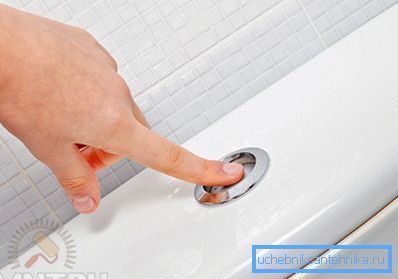
Peculiarities of the operation of the toilet tank system
The overwhelming majority of modern toilets are equipped with compact compact toilet bowls in which the flush tank is installed on a special ceramic platform, which is an integral part of the toilet bowl body.
This arrangement allows you to minimize the overall dimensions of the device, besides, it provides sufficient pressure of the drain water, and if necessary, makes it possible to perform routine repairs to the toilet bowl with a button with your own hands, without asking for help from professional plumbers.
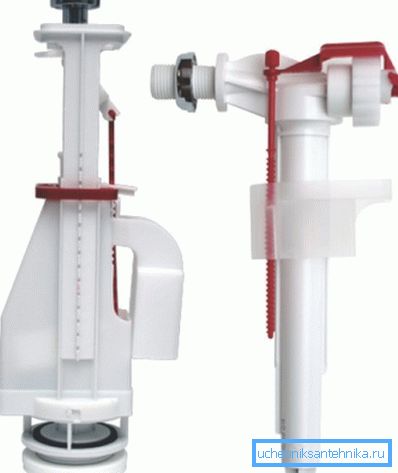
Internal device of a drain tank
Currently, the construction materials market has a wide range of plumbing fixtures, the price of which largely depends on the manufacturer, the material of manufacture, the complexity of the internal fittings and the functional features of the specific device.
In order to repair the toilet tank with a button on its own, you should know that with apparent external similarities, all such devices may have different shut-off and drain fittings, which in turn may be of several types.
- The upper supply of water with a lateral arrangement of the inlet pipe is most often used in low-cost models.. This scheme allows you to quickly do the installation and connect with your own hands, however, has a high noise level, which is created by the pressure of water.
- In the case of a lower water supply, the device of the toilet tank with the button is designed in such a way that the inlet and float valve are located in the lower part. Installation and maintenance of such devices is a little more difficult, however, they have a more aesthetic appearance, and they also have a low noise level when filled with water.

By the principle of descent of water, all devices are divided into two types: single-mode and dual-mode.
- Single-mode drain fittings provide for the descent of the entire volume of water by pressing the drain button once. It has a simpler design than the dual-mode system, but in some cases leads to unnecessary and inappropriate consumption of cold water.
- The release button of the dual-mode mechanism, as a rule, is divided into two unequal parts that can move in the housing independently of each other.. When you press a large part, the entire volume of water is released, and when you press a smaller part, only half of the total volume of the drain water enters the toilet. The internal structure of the toilet cistern with the dual-mode button is more complex, however, thanks to this design, significant savings in tap water are achieved.
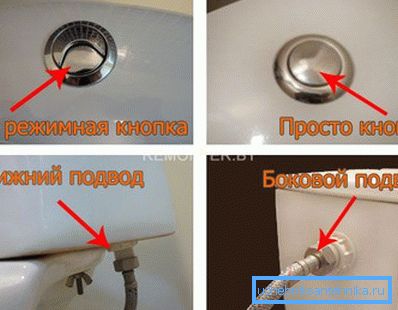
Note! Some models of dual-mode fittings can have one common button, and batch dosing of water can be adjusted by the duration or intensity of pressing it during flushing.
Repair of valves and fittings
The most frequent breakdowns of flushing the toilet can be a malfunction of the shut-off valve, or a malfunction of the drain fittings.
In any case, to perform the repair you need to know how to remove the lid of the toilet cistern with a button, so as not to damage its body, and not to break the fragile plastic parts of the internal reinforcement.
- First of all, it is necessary to close the stop valve, which is located between the supply pipe and the reinforced flexible hose.
- Before you open the lid of the toilet cistern with the button, you need to unscrew the outer chrome rim, which is located at the junction of the button to the lid of the cistern, pull it out, and then you can easily remove the top lid.
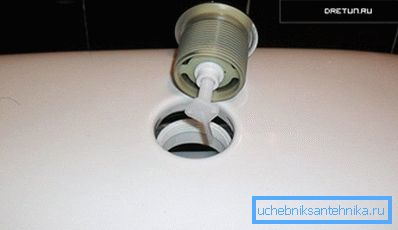
- The first thing you need to pay attention to the float. It must be absolutely hermetic, and not have visible damages and distortions, as well as traces of friction on the inner surface or parts of the internal fittings. If any, it should be replaced.
- Next, you need to check the operation of the hinge lever, with which the float is attached to the shut-off valve. It should have a smooth free run vertically, without jamming and failures.
- To check the operation of the shut-off valve, you need to drain all the water from the tank, and then open the valve supply pipe. When the float is lowered, water should flow freely into the tank, and when the float is raised to the maximum level, the shut-off valve should completely block its flow.
- If water does not flow, you should clean the internal lumen of the shut-off valve, and if it does not overlap, you need to replace the rubber seal, or adjust the position of the hinged lever of the float.
When significant faults are detected, the easiest way is to purchase and install a new set of valves. Such component parts are a consumable item, so they are sold in any hardware store and, as a rule, have a low cost.
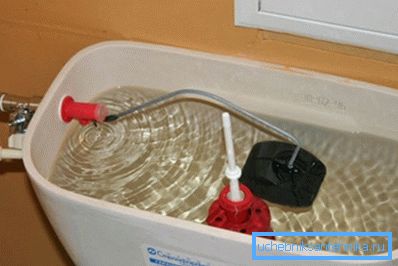
Tip! To reduce the noise level when filling with water, a rubber or plastic tube should be installed and fixed at the outlet of the shut-off valve, the lower end of which should end at the very bottom of the drain tank.
Repair of water drainage system
In case of a malfunction of the drain mechanism, before repairing the toilet bowl with a button, as well as in the first case, it is necessary to shut off the tap water supply and dismantle the top cover.
- After removing the cover, the first step is to check the integrity of the plastic rod that connects the button to the shut-off valve of the drain mechanism. If a breakdown or damage is found, it should be replaced.
- Next you need to check the integrity of the rubber diaphragm drain siphon. Its destruction leads to a constant flow of water into the toilet. To replace it, there are special repair kits, however, it is better to install a new siphon in inexpensive tank models.
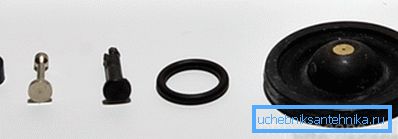
- The inner sleeve of the siphon seldom wears out; however, in case of its breakage, the spare part can also be found in the repair kit, or immediately install a complete new siphon in the assembly.
- Another reason for the incorrect operation of the water drain can be the entry of fine debris, rust particles, or fragments of internal fittings between the siphon sleeves, connecting rods, levers, or other parts of the drain mechanism.
To eliminate such problems, it is enough to disassemble and rinse thoroughly with water, and then properly assemble and install in place all the details of the internal valves.
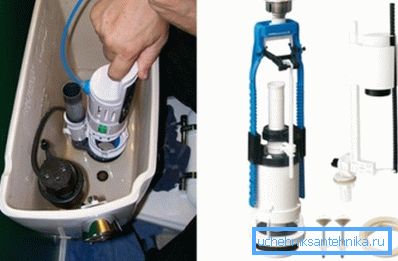
Tip! For those who are interested in how to disassemble the toilet bowl with a double button, we can recommend the same way: first, unscrew the round decorative bezel around the button by hand, pry it off than be sharp, and then remove the lid without any effort.
Conclusion
Finally, it should be noted that for durable and trouble-free operation of the cistern and the toilet as a whole, it is recommended to use fasteners and internal fittings made of non-corrosive materials, such as bronze, brass, stainless steel, for example, as well as various types of polymeric materials. (see also the article Button for cistern: design features and operating rules).
To get a visual representation of the internal structure of sanitary devices, you can watch the video in this article, or study similar materials on this subject on our website.